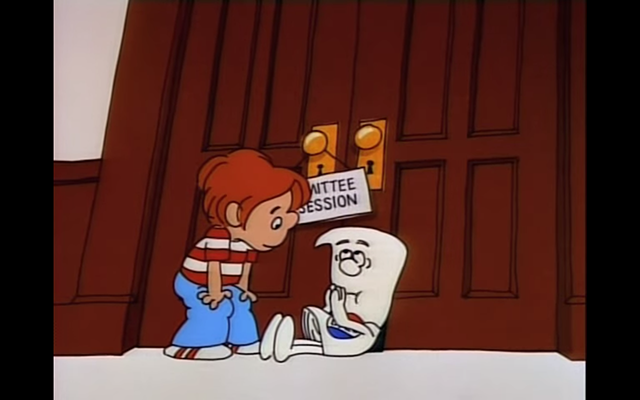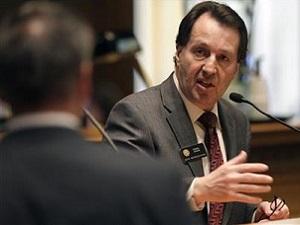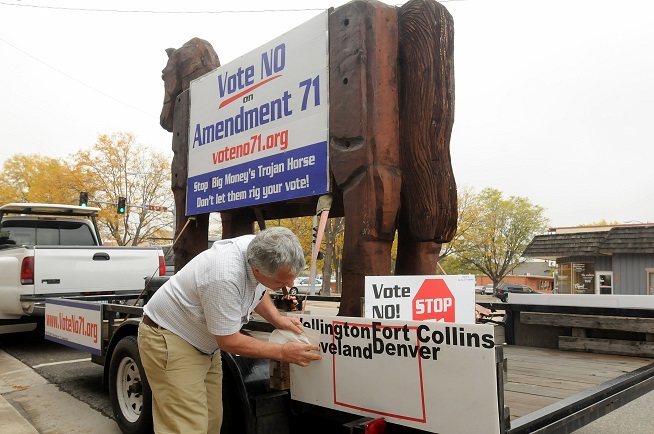Archive for category Colorado Politics
More From the Democratic Bad Idea Factory
Posted by Joshua Sharf in Colorado Politics on April 10th, 2018
 Back in the 1960s, Colorado lengthened its state legislative session from 120 calendar days to 160, reverting it back to 120 via a 1988 Constitutional Amendment. It’s still among the longest in the country, and two Democratic bills up in the State House of Representatives argue in favor of reducing it even further.
Back in the 1960s, Colorado lengthened its state legislative session from 120 calendar days to 160, reverting it back to 120 via a 1988 Constitutional Amendment. It’s still among the longest in the country, and two Democratic bills up in the State House of Representatives argue in favor of reducing it even further.
The first, HB18-1209, would prevent parents and grandparents from using 529 accounts to deduct the cost of K-12 private school tuition from their state income taxes. Under 529 accounts, parents and grandparents may pre-fund college tuition tax-free. The 2017 tax reform law extended that exemption to K-12 education under federal law, but it remained up to the individual states to decide whether 529 deposits would be tax-exempt under state taxes.
In this session, two competing an diametrically opposed bills were introduced in the House. HB18-1221 (sponsored by Republicans) would have explicitly allowed 529 funds to be used to K-12 tax free, but it was killed in committee. HB18-1209, which is still alive, would explicitly prevent 529s from being used that way under state law. It will probably pass the House, and it’ll be up to the Republican-controlled Senate to kill it in committee.
The objections to HB18-1221 were primarily from the teachers unions and their supporters. They argued that it was an attack on public education, but to be honest, you can’t really get there from here. The money would have been deductible from the general fund. It’s not a voucher, it’s not even a refundable tax credit. It would have reduced general fund monies, but wouldn’t have affected the school funding formula, and money wouldn’t “follow” the student from public to private schools, so on a per-pupil basis, anyone taking advantage of this would actually be increasing the per-student school funding in that district.
The other argument is that the public schools will suffer when the “better” students leave to go to private school. This claim is absurd on the face of it. If the better students are leaving, it’s because their parents think they can do better in a private school and are willing to pay for the privilege. Those parents are surely under no obligation to subject their children to an inferior education in addition to paying for it while they wait for their local school board to figure out what to do. The only way this claim makes any sense at all is if the mere existence of private schools poses a threat to public education.
This latter argument, by the way, was what swayed a majority of the local Jewish Community Relations Council not to support 1221, even though it would have made a substantial difference to many families struggling to pay day school tuition. Because apparently education is a Jewish value, unless it’s Jewish education.
The other product of the Bad Idea Factory is a government-run 401(k) for everyone in the state, known as HB18-1298. The bill reprises last year’s similar effort. Every business in the state with more than a certain number of employees, who doesn’t offer a retirement plan, would be required to participate in the state’s plan, and employees would be automatically opted in to participation, with the ability to opt out. That number of employees would ratchet down, going from 100 to 5 over a period of three years.
The real effect here – perhaps even the goal – is to force out privately-run 401(k) plans. It would have the effect of concentrating investment power in the hands of the government, and eventually forcing us all into the same, government-run retirement system. And they call me ideological.
More subtly, the authors of the bill accept at least two premises that those of us pushing for reform of the state’s catastrophically underfunded public pensions have been making for years. First, the bill explains that the DC plan won’t add to the state’s liabilities. Second, by making the plan opt-out rather than opt-in, they admit that default choices are sticky, that people tend to stick with them even if the effort required to switch is low. Which is why they want PERA to continue to default to the DB plan.
Third, and most critically, they admit that a DC plan can help people save for retirement in a constructive way that helps ensure security. And it raises the question – if a DC plan isn’t good enough for teachers and state employees, why is it good enough for the rest of us?
Most factories, if they continued to turn out products like these at such a rate, would go bankrupt and close up shop. The Democrats and the Left went intellectually bankrupt at least a decade ago, but unfortunately, don’t show any signs of going out of business.
SB200 Passes the Senate With No Democrat Votes
Posted by Joshua Sharf in PERA on March 27th, 2018
 SB200, the PERA reform bill, has passed the State Senate on a party-line 19-16 vote, with Sen. Cheri Jahn (U) joining the majority Republicans in support.
SB200, the PERA reform bill, has passed the State Senate on a party-line 19-16 vote, with Sen. Cheri Jahn (U) joining the majority Republicans in support.
It faces a tougher road in House, where the Democrats have a 10-seat majority, pending a Republican successor to evicted Rep. Steve Lebsock (D-R) in House District 34. But the bill has Democratic support, even among leadership. Majority Leader K.C. Becker (D) is one of the sponsors, and she’s been working with Sen. Jack Tate (R) since the beginning to get something written that can both pass and do more than just tweak things until the next crisis.
With a minority in the Senate, and the Republicans solidly behind the bill as amended, it was easy for Democrats to vote to oppose. They took no risk in doing so. What they could do was propose amendments that laid down markers for what the unions party expects to see changed coming out of the House and headed into a presumed conference committee. I covered those in a previous post, but they amount to:
- Reducing the employee contribution increase
- Increasing the employer contribution
- Not increasing the retirement age
- Not expanding access to the Defined Contribution plan
- Increasing the COLA cap
- Eliminating the new oversight committee
Now is where the Senate Republicans and House Democrats who have been leading the effort will really be tested. The needle to thread is much narrower, with Republicans more likely to vote against a substantially weakened bill, but Democrats potentially demanding more change to vote for it.
The Senate Democrats, in particular Sen. Rachel Zenzinger, complained that they were willing to compromise but that the Republicans had rejected such efforts. In fact, the final bill represented serious compromise from the Republican desiderata going in.
Will Becker and her co-sponsor Rep. Dan Pabon (D) be able to corral enough House Democrats to avoid poison-pill amendments, and have Sens. Tate and Priola been clear and convincing about just what those red lines are? Should a weakened bill make it out of conference, will enough Senate Republicans vote against it to offset any pickup in Senate Democrats. Recall that in the Senate Finance Committee, Sen. Jahn actually voted to support two amendments by Sen. Lois Court (D-Not Math) that ended up being proposed again on the floor.
We’re far from done. Let’s just hope they’re not still marking up amendments the first week in May.
Sen. Dan Kagan Emerges as Defender of PERA
Posted by Joshua Sharf in Colorado Politics, PERA on March 26th, 2018

In Friday’s debate on SB200, the PERA reform bill, Sen. Daniel Kagan (D-Cherry Hills) emerged as the floor leader of those fighting to defend the current system. Neither his positions nor his prominence on this issue should entirely be a surprise to observers.
Kagan’s district isn’t particularly left-wing: it’s got a 32000 – 27000 Democrat-to-Republican registration advantage, but also has 35,000 Unaffiliated voters. Kagan won his race against Republican Nancy Doty 53% – 47% in 2016, running slightly behind Hillary Clinton, who got 56% of the three-way vote among herself, Donald Trump, and Libertarian Gary Johnson. Located in suburban Denver, it’s a battleground district, but because of its loction also has a lot of PERA members and retirees.
Kagan reliably votes the Democratic line and has since his time in State House of Representatives, but has a way of conducting himself with civility and generally respects even hostile witnesses who come before his committees. The plummy British accent born of a well-to-do aristocratic upbringing probably doesn’t hurt as a public face, either.
On Friday, Kagan proposed three separate amendments, all of which could well have been written by the unions. The first would have restored an increase in the employer contribution, a 1.5% increase as compared with the 2.0% increase that was amended out in the Finance Committee. He used the traditional phrases about “shared sacrifice,” but also noted that the SAED enacted in 2006 was supposed to come from money from foregone raises, claiming that the nominal current 20.15% overstates the actual employer contribution.
This is an argument rejected by both the governor’s office and even PERA itself, whose former executive director, the late Greg Smith, testified before committee that it was his impression that school boards around the state were eating the SAED themselves rather than taking it out of teacher pay.
Next, he moved an amendment to raise the COLA cap from 1.25% to 1.75%, although he didn’t speak to that amendment.
Finally, he proposed L-013, comprehensively different plan altogether. These sorts of amendments are called “strike-through” amendments because they strike-through the whole of the bill, seeking to replace it with something else. In this case, the “something else” would restore the employer contribution to 1.5%, lowered the increase in the employee contribution to 1.5%, capped the COLA at 1.75%, increased the Highest Average Salary calculation from 3 years to 5 years (as opposed to the 7 in the bill), rescinded the increase in the retirement age, kept the calculation on net pay rather than gross pay, and prevented the expansion of the DC plan availability to all employees.
He defended this proposal by arguing that the plan’s actuaries confirmed that, according to their assumptions, it would put PERA on a path to 100% funding in 30 years. He claimed that PERA was not in “crisis” as in 2010, but did lack “resiliency,” especially since the adoption of more “conservative” assumptions. The language here is important. The term that the PERA Board would use for its November 2016 revisions in the expected rate of return and mortality tables is “realistic,” but this is incorrect – they are more conservative, and still far too optimistic. It is those assumptions that the actuaries are operating under.
He also derided the expanded DC plan availability as a “poisoned chalice,” that most PERA members rejected in favor of the shared responsibility and pooled resources of a DB plan that would always be there for people. I think it should be obvious to all but the most blind observer that the experience of the last 20 years shows that, absent continual adjustments, benefit cuts, and increased taxpayer contributions, the DB plan will not “always be there.”
Debate on this amendment – backed by the unions – will continue Monday morning when the Senate reconvenes.
SB200 and PERA Reform – The Good, The Bad, and The Missing
Posted by Joshua Sharf in PERA on March 23rd, 2018
Today, the State Senate is scheduled to debate SB18-200, the PERA reform bill, on the floor. As befits a big, complicated problem, it’s a big, complicated bill. As with any big, complicated bill it’s a mix of good and bad. In this case, there are also elements that are missing that would vastly improve the bill’s effectiveness and fairness.
And as with any bill, especially one in a divided legislature, there are political considerations. The bill is the result of several months of bipartisan effort, led by Republican Sen. Jack Tate and Democratic Rep. K.C. Becker, but also with the contributions of several Democratic senators and Republican representatives.
The Good

Photo Credit: Todd Shepherd
The Good in SB200 can be broken down into three parts. First, there’s the usual dial-turning and knob-twisting, but in this case, there’s also some screw-tightening and refitting. Second, there will be expanded legislative oversight. Third, there will be an expansion of the Defined Contribution plan. Let’s take each of these in turn.
The Dials and Knobs
The bill will increase contributions and decrease benefits in a number of ways:
- Employee contributions will step up another 3%
- Contributions will be calculated on gross, rather than net salary, reducing the incentive to game the system through deductions and spiking
- The Highest Average Salary will be calculated on 7 years, rather than the current 3 years
- COLAs will take a 2-year break, and then will max out at 1.25% per year
- The retirement age will increase to 65 for new and younger employees
- If needed to keep the plan on track, employee contributions and COLAs will be adjusted automatically
The retirement age increase and the COLA limits have been the main targets of PERA members, for obvious reasons. COLA limitations put almost all the inflation risk on retirees. Adjusting the retirement age for new employees is relatively uncontroversial – there is no group less organized than those who have not yet decided to sign an employment contract. But adjusting the retirement age for existing employees, even younger employees who have time to adjust, will have to be tested in the courts to see whether that’s considered enough of a “core” benefit to resist change.
Increased Oversight
The bill also calls for the creation of a new joint legislative committee, composed of six House and six Senate members, three from each of the caucuses, specifically to oversee PERA. The committee would also have four non-voting outside experts appointed by the Treasurer. Creation of this committee would create an in-house body of expertise, much like we have with the Joint Budget Committee, and which is lacking the legislature now. It would also allow outside experts to grill the Board publicly and hold it accountable – at least in words – for the effects of its decisions and recommendations.
Defined Contribution
Currently, State employees – but not teachers or other PERA members – have the option to choose the Defined Contribution plan when they join PERA. This bill would extend that option to all new PERA members, and it is one of the most reviled parts of the bill as far as PERA and the unions are concerned. They believe that it will work to undermine the DB plan, but they say that as though it were a bad thing.
The Bad
The bad was the increase in the employer (read: taxpayer) contribution. The original bill would have increased that by 2%, when employers are already putting in 20.15% of salary. For school districts who are already paying upwards of 1/8 of their operating expenses into PERA, this would tighten budgets even further. Small governments and municipalities would also be looking a 23-25% of salary going into PERA. Fortunately, this was amended out of the bill in the Finance Committee on a party-line vote.
So, if there’s only good, and not much bad, why isn’t the Independence Institute full-throatedly behind the bill? Because of…
The Missing
We believe that, as it stands, the bill can do some good, but represents a potentially substantial missed opportunity to do more to solve the problem over the long term.
Obviously, our preferred DC/DB mix would be to get rid of the DB option for all new employees to keep from perpetuating the problem into the future. That would still leave the unfunded liability of $50 billion to be dealt with. We would also like to see an option for current PERA members to change their choice and go to the DC plan. This could be done in a cost-neutral way, where members only take their own contributions and the actuarial value of their vested benefits with them, and PERA would be able to set the price.
Barring that, we would have preferred an entirely new, more conservative DB plan with no employee contribution above the normal cost, and separate accounting for employer contributions going to the normal cost and the unfunded liability.
The bill implements neither of those. At a minimum, therefore, the defined contribution should be the default option, rather than the defined benefit. In the first place, the default option tends to be “sticky,” meaning that people tend to stick with what they’re put into as a default. Leaving the DB as the default will tend to minimize DC participation. That leads to a potential political problem down the road, where low DC participation is cited as a reason to yank the option altogether.
Second, the new oversight committee is the minimum of governance reform. But it isn’t Board reform, nor does it prevent the Board from using public money to lobby the legislature for or (mostly) against additional proposed reforms. Allowing the Board to lobby against additional reforms raises the stakes for this bill, which is bad, but also increases the likelihood that we’ll end up back in the same place in a few years.
Last, PERA needs to take some accounting measures to keep itself on track. Namely, it should seek more outside advice than just its actuaries when estimating its expected rate of return. It should ask multiple investment firms to provide estimates of how well its current portfolio will do. It should also decouple its discount rate from its rate of return, using something like the Muni 20 Index. It will only do these things if required by law. For those who dismiss these requirements as details, we should remember that the current crisis was initiated when PERA lowered its expected rate of return from 7.5% to 7.25%. And for the knobs and dials to mean anything, the discount rate and rate of return need to reflect reality as well as they can.
We doubt that if a fix is passed, there will be any appetite in the short-term to pass additional reforms. PERA and its allies will reprise their call to let the current reforms work, as their did with SB-1 for the last 7 years. This bill is the chance to get things right, so let’s do that.
UPDATE: The Senate fought back floor amendments to raise the COLA cap and to restore the employer contribution. When the Senate adjourned, it was considering a “strike-through” from Sen. Kagan that would have replaced the proposed reform plan with one essentially written by the unions. That amendment would restore the employer contributions, raise the COLA cap, lower the employee contribution increase, retain the current retirement age, and eliminate the DC expansion. It will resume consideration of the bill and the amendment on Monday.
While it is likely that this amendment, along with all others to weaken the bill, will fail in the Senate, they also provide a preview of amendments that will be offered in the House, both in the Finance Committee and on the floor. Whether those amendments pass and force the bill to a Conference Committee will be the result of the efforts to defend against them by Reps. Pabon and Becker, and the level of commitment by Speaker Crisanta Duran to the bill’s integrity.
PERA Forum
Posted by Joshua Sharf in PERA on January 10th, 2018

On December 20th of last year, the South Metro Denver Chamber of Commerce hosted a forum on the future of Colorado’s deeply troubled public pensions, the Public Employees Retirement Association, or PERA.
PERA’s been in trouble for a while, but it only noticed how much trouble it was in late in 2016 when it adopted new mortality tables an a slightly less unrealistic estimate of its long-term rate of return. Since then, it’s been frantically trying to salvage the current defined benefit plan. PERA has a legislative proposal to tighten up COLAs, slightly increase the retirement age, increase contributions, and tighten up some loopholes in the benefit calculation formula. Governor Hickenlooper has released a plan of his own, similar to PERA’s with a few tweaks.
Independence Institute and I think the long-term solution needs to be more sweeping – a cutoff of the traditional pension plan for new members, and even providing the option for existing members to transfer into a new, 401(k)-style defined contribution plan. This won’t get rid of the massive, $80 billion unfunded liability, but it will keep it from getting any worse, and it will take the investment risk off the shoulders of the rest of the state and put it where it belongs, on the shoulders of the employees themselves.
The panel featured PERA’s interim Executive Direction Ron Baker, Amy Slothower representing the pro-reform Secure Futures Colorado, and Lynnea Hansen of the pro-PERA Secure PERA lobbying group, and me. It was moderated by State Senator Jack Tate (R-Arapahoe).
Here’s the audio from the event:
As you can see, things got most heated around the discussion of the composition and responsibilities of PERA’s Board of Trustees. Ron claimed the PERA’s Board was responsible for managing the money and administering the plan. That’s true, but as I point out, it’s far too modest. PERA’s Board also lobbies the legislature, posing as a disinterested unbiased source of information, but in fact opposing almost all interim reform proposals, including some that are now part of its proposed slate of reforms.
PERA and the 30-Year Amortization
Posted by Joshua Sharf in PERA on October 25th, 2017

In its campaign to sell its proposed reforms the PERA board has taken to emphasizing that the 30-year amortization period is written into Colorado statute. Per C.R.S. 24-51-211:
(1) An amortization period for each of the state division, school division, local government division, judicial division, and Denver public schools division trust funds shall be calculated separately. A maximum amortization period of thirty years shall be deemed actuarially sound. Upon recommendation of the board, and with the advice of the actuary, the employer or member contribution rates for the plan may be adjusted by the general assembly when indicated by actuarial experience.
Not only did they mention this at the Aurora tour stop last week, they tweeted it out last night.
The less rigorous standard means they never actually have to achieve full funding. PERA’s appeal to the authority of the law in this case rings hollow.
It’s the industry standard for public pensions, which is why it was written into the law in the first place. Presumably, if the industry standard were to change, the statute would change as well. Legislators aren’t experts in this material; they were clearly relying on the recommendations of the public pension stewards at the time. In effect, PERA is appealing to its own authority in this matter.
The fact is, industry standards for public pensions haven’t saved the industry from its problems. Not so long ago, the industry standard was a rate of return well over 8%. Right after SB1 was implements, PERA’ amortization periods all dropped under 30 years. That lasted all of one year.
The choice of a target amortization period should be based on whether or not it makes sense, not on appeals to authority that have proven less than authoritative over the years.
Photo Credit: Todd Shepherd
Bennet Takes the Path of Least Courage on Gorsuch
Posted by Joshua Sharf in Colorado Politics, National Politics on April 4th, 2017

Colorado’s Senator Michael Bennet has announced that he will not support the Senate Democrats’ filibuster of Gorsuch’s nomination, but that his vote on the nomination itself will depend on whether Senate Republicans move to change the filibuster rules, in which case all bets are off.
Conveniently, Bennet’s announcement came just as Senate Minority Leader Chuck Schumer claimed to have the needed 41 votes to sustain the filibuster.
Bennet has been under pressure here in Colorado to support Gorsuch’s nomination, for two obvious reasons – Gorsuch is unquestionably qualified for the Court, and he’s a fellow Coloradan. (In fact, Gorsuch’s childhood home is just a few blocks from where I live now.) This approach allows Bennet to maximize political posturing, while allowing others to do all the heavy lifting.
This is, perhaps, the most pointless partisan filibuster in all of history. Majority Leader McConnell has all but announced his intention to change the Senate rules to ditch the filibuster for Supreme Court nominations, the last remaining nomination filibuster permitted. In doing this, he is doing no more than Harry Reid intended that Chuck Schumer do, when the Democrats expected to retake the Senate and retain the White House back in November.
Bennet’s position allows him to pretend that he opposed the filibuster that forces McConnell’s hand, while knowing that other Democrats will carry that filibuster on without him. Then, he can avoid the question of Gorsuch’s merits by pretending to be outraged by the inevitable rules change.
It’s classic Bennet, who expressed doubts about the Iran deal, even playing on his own Jewish background, but then threw up his hands, shrugged, asked, “What can you do?” and voted to sustain the Senate Democrats’ filibuster of the resolution of disapproval, so as to avoid a recorded vote on the merits.
Bennet, always one to conserve political courage for another day, has stayed true to himself in his decision.
Why PERA’s Cumulative Returns Matter
Posted by Joshua Sharf in PERA on March 9th, 2017
PERA’s unfunded liability often comes into sharper after a year of low returns. Its detractors point to last year’s 1.5% return, for instance, as evidence that PERA’s expected rate of return is too optimistic (it is). Its defenders argue that a single year’s returns are less important than the long-term (they are). They then point to a time frame, say, the last 7 years, where PERA has averaged 9.7%.
But it’s not just average returns that matter. It’s cumulative returns, and there, even a couple of bad years can wreak havoc on a defined benefit plan.
Let’s look at PERA’s returns since 1990:

A few really bad years to start off the century, and we all remember 2008. But aside from that, mostly above expected, and a few years slightly below expected. If you had invested $100 in PERA Mutual Fund in 1990 and let it sit for a quarter century, you’d be about where you should be, based on each year’s expected rate of return. Most years, you’re even ahead of the game, before the dot-com burst and the housing bubble burst bring you back to earth.

But of course, you don’t put $100 in in 1990 and let it sit. You put $100 in every year. Instead of looking at this from the perspective of each year going forward, let’s choose the perspective of 2015 looking back at each year. That is, for each year where you’ve invested $100, let’s see how you end up in 2015.

For $100 invested in 1990, you’d expect to have about $800, and we already know that that’s what you’ve got. For $100 invested in 2000, though, you’d expect that to be worth $355 today, but it’s only appreciated to $228. That’s because in January 2000, you invested before the bad years of 2000-2002. So money invested in every year from 1995-2003 is worth less now than PERA’s expected return would project. In fact, there are only a few years where the cumulative return through 2015 is better than expected, because 2000-2002 and 2008 wipe out all the gains beyond expectations.
Not surprisingly, this means that your PERA Mutual Fund is short of expectations in 2015, by just over 9%. You’d expect to have just over $9000, but instead you’re just under $8200.
Naturally, PERA’s actual situation is much more complex than this. But the point remains – it’s not enough to do as well as you’d expect over a long period of time, even in the absence of required annual payouts. In order to keep the plan solvent, you need to do better than that.
PERA Admits Problem – Blames Legislature
Posted by Joshua Sharf in PERA on January 4th, 2017
 Could people be catching on to the shell game / ponzi scheme that is Colorado’s public pension system? If the Denver Post can start running critical articles, then anything’s possible.
Could people be catching on to the shell game / ponzi scheme that is Colorado’s public pension system? If the Denver Post can start running critical articles, then anything’s possible.
Yesterday (“‘Alarm bells’ raised: PERA stability again under scrutiny“), the Post noted that even PERA is admitting that it’s going to take longer to reach fully-funded status than had been previously estimated.
Wow! Who could have predicted this? It’s a shame nobody’s been around to tell them this might happen.
PERA is paying particular attention to the Judicial Fund, which is projected never to crash and burn, but never to achieve fully-funded status. It’s like a pension version of Purgatorio. We’ve been here before with larger funds, and indeed, the Denver Public Schools Fund also has an infinite amortization period.
The Judicial Fund is tiny. The DPS fund isn’t huge itself. The state could easily just pay these pensions out of current cash.
The State and School Funds, however, are gigantic by comparison, and have the potential to crush state and school budgets. Their amortization periods are now around 45 years, and headed in the wrong direction. The amortization period varies wildly with relatively small shifts in return because we’re operating so close to the margin. It’s not the 10 year shift itself that’s worrisome, it’s the fact that we’re so close to infinity to begin with.
PERA with good amortization. A small difference in the funded level doesn’t change the date much. This is ok, as long as you don’t drift too far off center.

PERA with bad amortization. A small difference in returns sends you first to the brink, and then spinning off into space, helpless, never able to retire. You just don’t want to be operating in this region.

PERA, like most public pensions, relies on “time diversification,” or the idea that over the long term, average expected returns are the best guide to what will happen. But they’re not the best guide to what the risk is to the fund, the retirees, and the citizens of the state. The paradox is that even as average returns converge, where you end up at the end of 30 or 40 years spreads out.
It’s like the pension version of “gas expands to fill the available space.” Imagine if I brought a canister of chlorine gas into the room and took the top off of it. Sure, the center point would stay the same, but pretty quickly we’d be all DIA murals.
In the same way, the expected returns converge to the mean, but the number of things that can happen, the number of different balances you can end up with, grows, and therefore so does the risk of one of those balances being negative.
PERA itself has acknowledged this. Its own study in 2015 showed a better than 1-in-6 chance that the School and State Funds would crash and burn sometime in the next 30 years, based solely on variations in expected returns:

When PERA runs into trouble, it will likely be because of low investment returns. The state will then likely try to come to the taxpayers to bail it out. It may even be forced to do so by the courts.,
The problem is, the taxpayers have their retirement money in mostly the same places of PERA, and will have also been seeing low returns on their own retirement portfolios. Basically, the state will be demanding money from people who don’t have it, in order to honor promises they didn’t make.
As a taxpayer, I’m mad. But I’d also be mad if I were in the legislature. Here’s PERA Executive Director Greg Smith:
“You all put together a 30-year plan to recover from that,” Smith told lawmakers. “We’re six years in, and we’re behind. And we’re going to go and talk about how can we get back on track for what that plan was.”
“You all?” Yes, that’s true. The Legislature had to vote on the plan. But it was informed by PERA’s Board, who not only backed SB1, but also had a huge part in drafting it and commenting on its provisions. Every year, every time the question has come up, PERA’s Smith has said that things were just fine. Every time anyone proposed changes to make it more robust – better reporting, small tinkering at the edges, larger more substantive improvements – PERA’s Smith has been there with his merry band of union and retiree groups arguing against them.
This is Exhibit A of why we need to move to a defined contribution plan and take these decisions out of the hands of elected officials. Legislators aren’t (all) dumb, but they’re not specialists, and they rely on experts like Smith to inform them about what needs to be done. But Smith and PERA as a whole have a vested interest in telling them that everything is fine, or that more money from taxpayers will fix the problem.
Moving to a 401(k)-style plan, or even a cash balance plan, would help insulate everyone from the politics here.
No On Amendment 71
Posted by Joshua Sharf in Colorado Politics on October 16th, 2016
 This year, one of the more controversial ballot measures is a proposed State Constitutional amendment to limit State Constitutional Amendments. It has some superficial appeal: In some years past, a fair number of amendments have passed, and the State Constitution is supposed to be a foundational document, not just a compilation of what some people in a given year think are cool ideas. This year, a number of out-of-state environmental groups tried and failed to get anti-energy initiatives on the ballot, and Amendment 71 is in large part a response by the energy industry to that effort.
This year, one of the more controversial ballot measures is a proposed State Constitutional amendment to limit State Constitutional Amendments. It has some superficial appeal: In some years past, a fair number of amendments have passed, and the State Constitution is supposed to be a foundational document, not just a compilation of what some people in a given year think are cool ideas. This year, a number of out-of-state environmental groups tried and failed to get anti-energy initiatives on the ballot, and Amendment 71 is in large part a response by the energy industry to that effort.
The measure has three main parts:
- New amendments would require 55% to pass
- Petitioners would need 2% of the registered voters in each State Senate district
- Old amendments would still only require 50% for repeal
While US State Constitutions have never been held in the same reverence as the US Constitution, I’m open to the idea that it’s too easy to get bad ideas on the ballot, and that in a given bad year, some of those ideas will end up being enshrined there. Certainly an ongoing government-by-plebiscite is a dangerous way to govern.
But Amendment 71 is a bad idea whose time has not yet come.
Political power is a zero-sum game. In theory, the citizens of Colorado have a number of options for checking the power of the state government. They have the right to overturn laws at the ballot box. They have the right to put new laws onto the ballot. And they have the right to put Constitutional amendments on the ballot.
As will be the case, the state legislature has systematically moved to negate those checks. Citizens may overturn only those laws that are not deemed to be for the public peace, health, and safety. As a result, the legislature routinely adds the so-called “Safety Clause” to even mundane measures, in order to protect them.
[youtube]https://www.youtube.com/watch?v=b0aHx1mhCeY[/youtube]
Colorado also has no hold-harmless period for citizen-initiated statutory changes. In effect, the state legislature can immediately overturn any statutory change with a simple majority vote. Constitutional amendments, on the other hand, require a 2/3 vote in each house to be placed on the ballot for repeal. This may explain why the Constitutional route is so popular.
But by considering this (potential) problem in isolation, the proponents are demonstrating political tunnel vision.
Amendment 71 would make it harder to rein in the state legislature, while doing nothing to prevent the legislature from imposing its will on the people. It does nothing to limit the abuse of the Safety Clause, and it does nothing to create a hold-harmless period for citizen-initiated statutory changes. It represents a staggering net shift in power towards those interests who have existing money and organizational ability to get measures on the ballot, and away from the citizenry’s ability to limit legislative power.
I know some of the people involved on the pro-71 side, and I don’t question their sincerity, only their judgment. In 2008, when I was running for State House of Representatives, then-State Senator Greg Brophy and I met up at an issues forum sponsored by Hadassah. On the ballot was Referendum O, a measure to tighten up the process for amending the State Constitution. Greg was in favor then, and I opposed it, so while he’s a paid spokesman for the A71 group now, he comes by his support honestly, and is hardly “bought” as some have suggested.
But Greg, of all people, should know from his own experience how flawed his arguments are. The State Constitution is no guarantor of our rights at all when the State or US Supreme Court willingly interprets it to benefit a political agenda.
Consider the 2013 gun law recalls. Two Democrats – from what were drawn as safe Democratic seats – were recalled over the 2013 bills and replaced by Republicans. A third from a competitive seat was at risk until she resigned to make sure that a Democrat could succeed her.
And yet. After that, after the Democrats won back those seats and still lost control of the State Senate, after they nearly lost control of the State House, the laws remain on the books, and have survived court challenges. The Democrats are bound and determined to ignore clear signals from the electorate that they’re on the wrong side of this issue, and have simply no real incentive not to pursue further changes as their electoral majorities allow.
Brophy himself declared from the well of the Senate, “I will not obey this law!” That alone showed that he understood that the guarantor of our rights is not the Constitution or the courts but ourselves.
Much of the appeal on behalf of Amendment 71 has come to rural Republican voters, who rightly feel targeted by a number of bad Constitutional initiatives put on the ballot by Boulder and Denver liberals. The argument is that, with the State Senate signature distribution requirement, they’ll be able to block bad ideas at the signature-gathering stage. But when A71 proponents failed to meet their own standard, they didn’t fall short in the rural districts. It was in some of the liberal college districts in Ft. Collins and Boulder, who have more registered voters and thus a higher signature threshold. In all likelihood, A71 would do more to let those districts block ideas desired by the rest of the state than to keep them from imposing their bad ideas on us.
In a year when the Democrats have an excellent shot at taking back the State Senate, giving them control of the whole legislature and the governorship, it’s a terrible idea to limit the citizens’ potential checks on that government.



